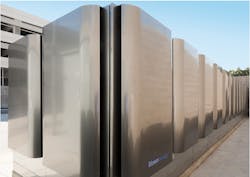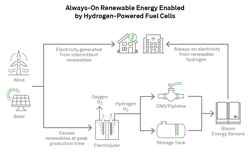Hydrogen-Powered Energy Servers Deliver Always-On Renewable Electricity
The race to reduce greenhouse gas emissions is the defining challenge of our generation. The world needs more clean and renewable power quickly, but the accelerated deployment of renewables comes with multiple challenges, including reliability, resiliency, scalability, and land use.
At peak times, we already have more renewable power than the grid can handle in some U.S. states and territories. Despite those periods of excess wind and solar power, because we lack the ability to store electricity for more than a few hours, dispatchable power from the combustion of fossil fuels continues to bridge gaps in supply.
At the same time, we experience more power outages than ever before. Wildfires, tornados, hurricanes, and winter storms cause hundreds of outages every year, with more outages lasting days, not minutes or hours. Now, more than ever, we need power that is renewable, reliable, and resilient.
Bloom Energy offers the world’s most efficient commercially available electricity generation device, the Bloom Energy Server, which delivers low carbon dioxide and pollutant-free emissions. Recently, Bloom Energy has announced a new capability that efficiently delivers always-on, 100% renewable electric power with no emissions 24 hours per day, 365 days per year.
How Does it Work?
Current Bloom Energy Servers generate electricity using natural gas or biogas as fuel. Deployed by 25 of the Fortune 100, Bloom Energy Servers already reduce greenhouse gas emissions by amounts comparable with zero-emission wind and solar power on an annual basis.
The ability to operate on renewable hydrogen means Bloom Energy Servers installed at present to run on natural gas can be readily upgraded on site to use renewable hydrogen in the future.
Renewable hydrogen is becoming more available in some states and countries. It is produced by breaking down water into hydrogen and oxygen using electrolysis and renewable power. More than 200 water electrolysis projects have come online since 2000, with many more larger electrolysis projects announced in the United States and Europe.
Bloom Energy Servers can operate on pure hydrogen or a combination of natural gas and hydrogen. As the availability of renewable hydrogen increases, it could also be blended into the natural gas pipeline network. The National Renewable Energy Laboratory has concluded that blending up to 15% hydrogen into the natural gas supply will not significantly impact household appliances, public safety, or the durability and integrity of the natural gas pipeline network.
When Will the Market for Hydrogen-Powered Fuel Cells Mature?
Bloom Energy anticipates early demand for hydrogen-powered fuel cells in Asia, where hydrogen production and use are being actively developed by countries including France, Japan, Korea, and Australia.
In the United States, many experts anticipate increased use of hydrogen playing a critical role in the decarbonization of the energy sector.
Modularity and Availability
Conventional power plants, even those operating on renewable hydrogen, require enormous amounts of space, whereas Bloom Energy Servers can be placed virtually anywhere where renewable hydrogen, natural gas, or biogas is available. A typical 250-kW energy server produces enough electricity to power a big box store in an area about the size of a parking space. Any number of energy servers can be clustered together in various configurations to form solutions from hundreds of kilowatts to many tens of megawatts in a compact footprint.
Bloom Energy Servers being shipped today can be adapted to run on hydrogen with a system upgrade.

